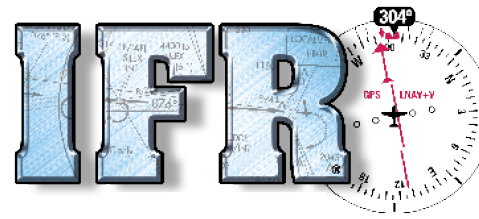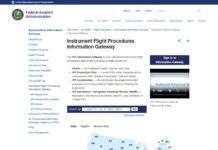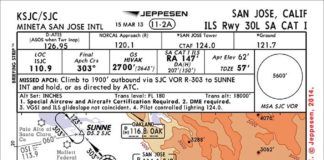As always, January’s “Incommunicado” is an excellent article from Tarrance Kramer. The article about the fun-and-games of losing communication between pilot and ATC, from the controller’s point of view, prompted some thoughtful discussion around here, confirming once again we periodically need to review the pilot’s rules for NORDO (none of us could recite, from memory, the rules for route and altitude).
The section “Study in Contrast” described a Cherokee driver who did it right, flying to his clearance limit airport, then initiating an approach at the expected altitudes. That’s all well and good, but let’s toss a monkey wrench into that pilot’s lap: The weather at the intended destination has just gone into the toilet. Instead of OVC030, it’s 1/4SM FG VV002; the pilot misses. Now what?
There are at least two parts to the “now what” question. Part One is at least somewhat covered by the approach chart: The pilot flies the missed approach procedure courses and altitudes, and winds up at a hold. That’s what everyone should expect. So far, so good.
Part Two isn’t as easy. The pilot is still NORDO, so the miss can’t be reported to ATC, nor can any additional clearance be requested or received. We’re back to “now what”?
Here’s what we finally came up with after batting it around for a while.
1. This is a for-real emergency. The pilot has the authority—and the responsibility—to do whatever it takes.
2. We assumed the pilot’s flight plan included at least one alternate, but we don’t know if that’s information the controller has ready access to.
3. We also assumed the pilot can still navigate—somehow. If not, then the best plan might be to fly in the direction of the closest VFR weather and hope to find landmarks that lead to an airport.
4. It boils down to: what destination, what route and what altitude?
a. Destination is the alternate in the flight plan. If one wasn’t filed, it’s time to pick one, based on what the pilot found in pre-flight weather research. The “direction of the closest VFR weather” might be the best choice. If ATC can’t find the filed alternate, or one wasn’t filed, ATC will have to figure it out based on radar tracks. (See note below.) If VMC is ever encountered long enough to find an airport, the destination changes to the airport in sight. Land now.
b. Route? We didn’t see any better option than “direct,” unless GPS isn’t available, then some cobbled-together VOR-to-VOR/airway route will have to be figured out.
c. Altitude? This prompted a lively discussion. If following Victor airways, MEA is a good choice, whether the VOR-based MEA or the (perhaps lower) GPS MEA, depending on what’s being used for navigation. Off-airway, I argued for OROCA but cogent arguments for MOCA and MORA were also made. Whatever altitude is chosen, we decided that any climb necessary to reach it should be done while still in the hold at the end of the missed approach.
5. By the time the NORDO aircraft reaches the alternate destination, we figured ATC would have cleared all other traffic away, so it’s Pilot’s Choice for which approach to fly. Unless the pilot can join a “NoPT” route into the approach, we figured the depicted procedure turn (or HILPT) should be flown.
6. If the alternate is a towered field, light gun signals should be expected, but we decided we would land even without them. Only a red signal would give us pause, and some argued for landing anyway and explaining it later. It’s an emergency, right?
7. Post landing actions fell into several categories. First, a trip to the FBO’s lavatory, then phone calls (local tower? clearance delivery? FSS?). Later came sorting out the cause of communications failure and repairing it. Adult beverages came into there somewhere, too. A NASA ASRS report would probably also be a good idea.
Note from 4a above: What if the pilot’s location or altitude preclude radar? We kind of gave up on this one. From the pilot’s point of view, it doesn’t really change anything, but we also guessed at that point it’s full-panic mode for ATC. All ATC knows is that no “cancel IFR” report has been made. Is the airspace all the way to the missed approach hold cleared? We didn’t know. Does every hold have radar coverage (we guessed not)? So ATC might not know the NORDO aircraft has arrived at the hold, nor if/when it departs on its way to the alternate. If the gods are smiling, maybe the NORDO aircraft will eventually show up as a target on some radar scope, either squawking the original code or 7600, and so get identified again. If it doesn’t, how does ATC even know the aircraft missed and is on its way to someplace else, instead of sitting at the bottom of a smoking crater?
No matter how much we tossed the topic around, it eventually came back to point number one above: This is an emergency. We hope it turns out well.
Tom Skelton
Mason, Michigan
It’s very gratifying that an article provoked such deep thought and analysis. Thank you for your note.
First, every situation is different, so there’s no one-size-fits-all solution. The main thing is to use all of your resources, and think outside the box.
Unfortunately, ATC does not have ready access to a pilot’s filed alternate airport information. However, we can contact Flight Service for any information on the flight plan.
Outside the box: If the pilot is low enough for cell phone coverage, the pilot can call the local ATC facility on his cell phone. I’ve actually had someone do this before, a VFR giving me a heads up in the tower that they were inbound with no radios. When they got in the vicinity, I gave them a green light gun to land.
If he doesn’t don’t know the number, try 911. It’s an emergency, right? Tell them you’re an aircraft in the air, in trouble, and need the number for the local control tower. They should be able to track it down. [Now that most small airports publish an ATC phone number for clearances, that’s another resource for phone numbers. —Editor]
If in contact with ATC via phone, information can be passed back and forth. The pilot can tell us how much fuel he has and how many people are on board. We can tell him airports that are within range with better weather and directions towards VFR weather. He can also let us know if there’s anything else wrong with the aircraft (instrumentation, avionics, powerplant, etc.) The main things we need to know are his capabilities and his intentions.
We will continuously track the aircraft and protect the airspace around it as best we can predict. If we see him making a beeline for somewhere, we can also warn that airport or facility to be on the lookout. Flying at or above the MEA makes it more likely we’ll have good radar coverage.
Alternately … if the worst happens or if he finds an off-airport site to land (field, road, etc.) … we will know where to send search and rescue. We can put a hold on a target, so the radar will keep the target up even if the aircraft drops below coverage (i.e. lands or crashes). We can then get the lat/longs and send them to the search and rescue or law enforcement. We will also have aircraft monitor Guard for an ELT, which can be used to triangulate a crashed aircraft’s exact position. If a crash does appear to have occurred, we can enlist nearby aircraft to try and get eyes on the aircraft, whether it’s crashed or landed on a road or something. Only once have I had someone refuse to help. (And I hope karma gets that guy good!)
If there are other aircraft in the area, we can attempt to have them visually locate the NORDO and perhaps get them to follow them to an area with better weather. However, with no way to communicate aside from wing-waves or light flashes, how do they know what to do? Also, we’re introducing a collision risk by asking them to get close to an uncommunicative aircraft and surprise them.
On #6, the tower will hopefully be made aware of the NORDO situation by the overlying radar facility and should be protecting the flight path and be ready with the green light gun signal. The only reason I can foresee a red light being used is if the NORDO is trying to land on a runway that’s closed for construction or repair (i.e. has a damaged surface or equipment on it.) and is in critical danger. Ignore the red light at your own risk.
Non-Radar? I’ve personally never worked non-radar airspace. If the aircraft is below coverage, we simply don’t know the aircraft’s status. Horrible as it sounds, until we get either a phone call, eyes on him, or someone hears an ELT, there’s no way of knowing if he’s still airborne. On the radar side, climbing while in the hold will hopefully get you back into coverage. However, on the pilot side, how do you know when you get back into coverage? The MEA and OROCA have nothing to do with ATC radar coverage, and ATC Minimum Vectoring Altitudes aren’t published for general use. But the higher you go, the better your chances.
Everyone—both the pilot and ATC—should expend every resource and effort in the interest of a safe outcome. What that looks like depends on the details of the situation. And yes, of course, in an emergency the normal rules go out the window. You absolutely should do what you need to do to get on the ground safely.
Related sidenote: An acquaintance of mine received the NATCA president’s award last year for saving a pilot’s life, using every resource he had. A Cessna crashed on a riverbank in his airspace, and its owner reported the aircraft overdue. While the owner jumped into a different airplane to look for the downed Cessna, my fellow controller used a radar playback to find the site. Despite storms in the area, they successfully located the crash site. He had a military helo check it out, but they couldn’t directly assist due to fuel concerns. Waterborne rescue personnel got on site, but there was no way to drive the severely injured pilot out. The local LifeFLight helicopter couldn’t go because they were on a mandatory cooldown period.
The controller then contacted a neighboring TRACON and asked them to send one of their locally-based Coast Guard HH-65 helos who was on a training sortie, but had no EMT aboard. The CG helo flew out, dodging thunderstorms, landed by the river, picked up the hurt pilot and an EMT from the water rescue unit, and then flew on to a local—but unfamiliar—hospital. On its way there, the controller had one of the local LifeFlight pilots guide him in. It was an amazing “save” using everything he had on tap. Here’s the video from the ceremony, including radar footage and radio recordings: https://www.youtube.com/watch?v=HY6V4MsGfMQ





